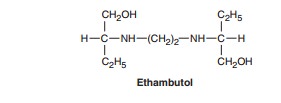Chapter: Basic & Clinical Pharmacology : Antimycobacterial Drugs
Ethambutol - Drugs Used In Tuberculosis
ETHAMBUTOL
Ethambutol is a
synthetic, water-soluble, heat-stable compound, the dextro-isomer of the
structure shown below, dispensed as the dihydrochloride salt.

Mechanism of Action & Clinical Uses
Susceptible
strains of Mycobacterium tuberculosis
and other myco-bacteria are inhibited in vitro by ethambutol, 1–5 mcg/mL.
Ethambutol inhibits mycobacterial arabinosyl transferases, which are encoded by
the embCAB operon. Arabinosyl
transferases are involved in the polymerization reaction of arabinoglycan, an
essential component of the mycobacterial cell wall. Resistance to ethambutol is
due to mutations resulting in overexpression of emb gene products or within the embB
structural gene.
Ethambutol is well
absorbed from the gut. After ingestion of 25 mg/kg, a blood level peak of 2–5
mcg/mL is reached in 2–4 hours. About 20% of the drug is excreted in feces and
50% in urine in unchanged form. Ethambutol accumulates in renal fail-ure, and
the dose should be reduced by half if creatinine clearance is less than 10
mL/min. Ethambutol crosses the blood-brain bar-rier only when the meninges are
inflamed. Concentrations in cerebrospinal fluid are highly variable, ranging
from 4% to 64% of serum levels in the setting of meningeal inflammation.
As
with all antituberculous drugs, resistance to ethambutol emerges rapidly when
the drug is used alone. Therefore, ethambutol is always given in combination
with other antituberculous drugs.
Ethambutol
hydrochloride, 15–25 mg/kg, is usually given as a single daily dose in
combination with isoniazid or rifampin. The higher dose is recommended for
treatment of tuberculous menin-gitis. The dose of ethambutol is 50 mg/kg when a
twice-weekly dosing schedule is used.
Adverse Reactions
Hypersensitivity
to ethambutol is rare. The most common serious adverse event is retrobulbar
neuritis, resulting in loss of visual acuity and red-green color blindness.
This dose-related adverse effect is more likely to occur at dosages of 25
mg/kg/d continued for several months. At 15 mg/kg/d or less, visual
disturbances are very rare. Periodic visual acuity testing is desirable if the
25 mg/kg/d dosage is used. Ethambutol is relatively contraindicated in
chil-dren too young to permit assessment of visual acuity and red-green color
discrimination.
Related Topics